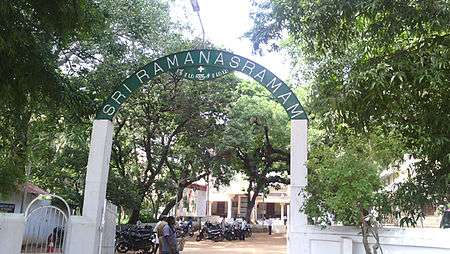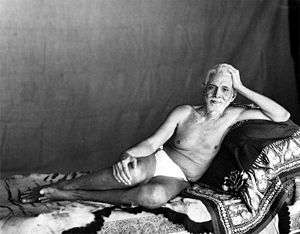Sri Ramana Ashram

Sri Ramana Ashram, also known as Sri Ramanasramam, is the ashram which was home to modern sage and Advaita Vedanta philosopher Ramana Maharshi from 1922 until his death in 1950. It is situated at the foot of the Arunachala hill, to the west of Tiruvannamalai, Tamil Nadu, where thousands of seekers flocked to be in his presence. His samadhi shrine continues to attract devotees from all over the world.[1]
History


The ashram gradually grew in its present location after Ramana Maharshi settled near the Samadhi shrine of his mother Alagammal, who died on May 19, 1922. In the beginning, a single small hut was built there. By 1924 two huts were set up, one opposite the samadhi and the other to the north.
Amongst its early western visitors were British writer Paul Brunton in 1931, who is credited with introducing Ramana Maharshi to the West through his books "A Search in Secret India" (1934) and "The Secret Path". Writer W. Somerset Maugham visited the ashram in 1938, and later used Ramana Maharshi as the model for the holy man, Shri Ganesha in his novel, The Razor’s Edge (1944).[2][3] Other visitors included Swami Sivananda, Paramahansa Yogananda,[4] Alfred Sorensen (Sunyata) and Wei Wu Wei.[5]


Arthur Osborne stayed at the Ashram for twenty years, and edited the Ashram's journal, The Mountain Path, besides writing several book on Ramana Maharshi and his teachings. Mouni Sadhu spent several months at the Ashram in 1949.[6] David Godman came to the ashram in 1976, and has since written or edited fourteen books on topics related to Sri Ramana Maharshi. He continues to live near the ashram.
Niranjananda Swami, younger brother of Ramana Maharshi, who had moved to the ashram along with his mother in 1916, stayed at the ashram for the rest of his life and handling its management. His son and grandson have looked after the ashram in turn.[7]
See also
Notes
- ↑ Sri Ramana Ashram Tiruvannamalai district website.
- ↑ Zaleski, p. 219
- ↑ "Eastern promise". Mint (newspaper). May 17, 2008.
- ↑ Yogananda , p. 384
- ↑ Sri Ramanasramam history
- ↑ Mouni Sadhu, 'In Days of Great Peace' 2nd. revised edition pub. 1957 by G Allen and Unwin
- ↑ Osborne, p. 119
References
- Abram, David (2003). The Rough Guide to South India. Rough Guides. ISBN 1-84353-103-8.
- Ebert, Gabriele (2006). Ramana Maharshi: His Life. Lulu.com. ISBN 1-4116-7350-6.
- Self-Realization: The Life and Teachings of Bhagavan Sri Ramana Maharshi, by B.V. Narasimha Swami (ISBN 81-88225-74-6)
- Yogananda, Paramahansa (2008). Autobiography of a Yogi. Diamond Pocket Books. ISBN 81-902562-0-3.
- Zaleski, Philip; Carol Zaleski (2006). Prayer: A History. Houghton Mifflin Harcourt. ISBN 0-618-77360-6.
- Osborne, Arthur (2000). "12. Sri Ramanasramam". Ramana Maharshi and the Path of Self Knowledge. Jaico Publishing House. ISBN 81-7224-211-5. online text
Further reading
- My life at Sri Ramanasramam, by Suri Nagamma. Pub. Sri Ramanasramam, 1975.